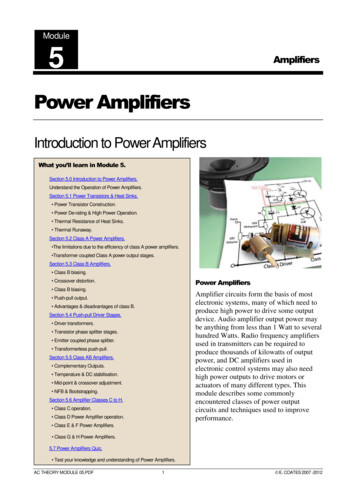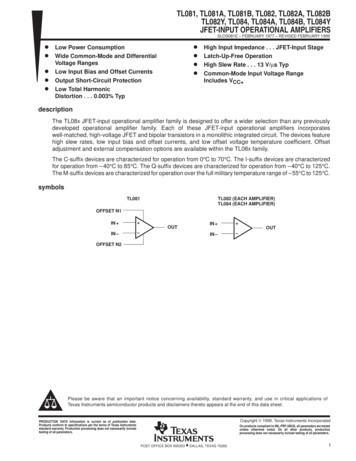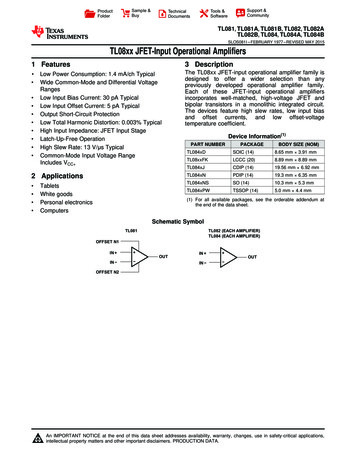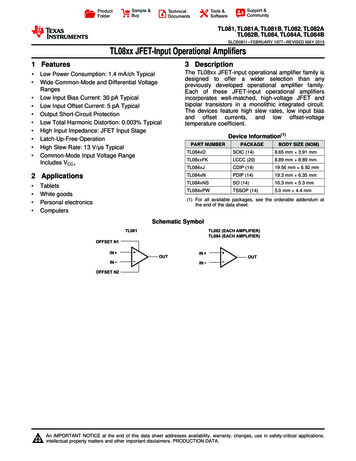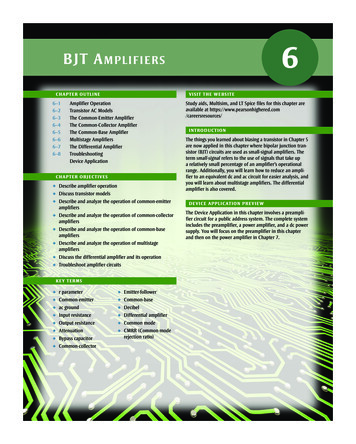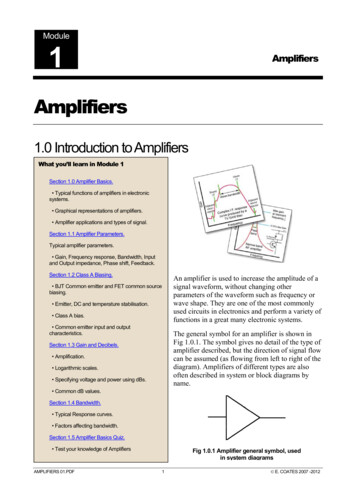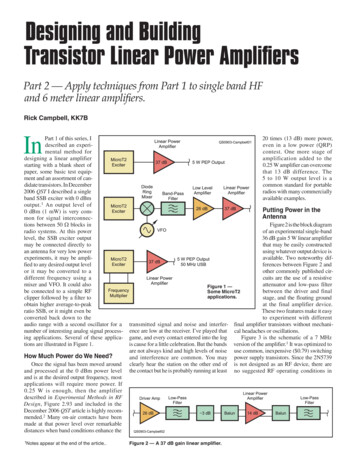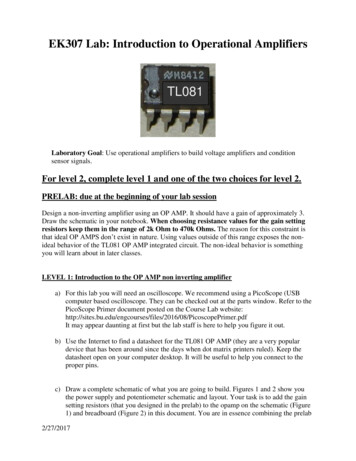
Transcription
EK307 Lab: Introduction to Operational AmplifiersTL081Laboratory Goal: Use operational amplifiers to build voltage amplifiers and conditionsensor signals.For level 2, complete level 1 and one of the two choices for level 2.PRELAB: due at the beginning of your lab sessionDesign a non-inverting amplifier using an OP AMP. It should have a gain of approximately 3.Draw the schematic in your notebook. When choosing resistance values for the gain settingresistors keep them in the range of 2k Ohm to 470k Ohms. The reason for this constraint isthat ideal OP AMPS don’t exist in nature. Using values outside of this range exposes the nonideal behavior of the TL081 OP AMP integrated circuit. The non-ideal behavior is somethingyou will learn about in later classes.LEVEL 1: Introduction to the OP AMP non inverting amplifiera) For this lab you will need an oscilloscope. We recommend using a PicoScope (USBcomputer based oscilloscope. They can be checked out at the parts window. Refer to thePicoScope Primer document posted on the Course Lab 08/PicoscopePrimer.pdfIt may appear daunting at first but the lab staff is here to help you figure it out.b) Use the Internet to find a datasheet for the TL081 OP AMP (they are a very populardevice that has been around since the days when dot matrix printers ruled). Keep thedatasheet open on your computer desktop. It will be useful to help you connect to theproper pins.c) Draw a complete schematic of what you are going to build. Figures 1 and 2 show youthe power supply and potentiometer schematic and layout. Your task is to add the gainsetting resistors (that you designed in the prelab) to the opamp on the schematic (Figure1) and breadboard (Figure 2) in this document. You are in essence combining the prelab2/27/2017
schematic to the figure 1 schematic. Before starting to build the circuit make sure youhave a complete schematic in your notebook. It will help you make the circuit.d) The potentiometer voltage divider shown in figures 1 and 2 is used as the input for yournon-inverting amplifier. A potentiometer is a variable resistance voltage divider device.It is useful for making voltage adjustments when you don’t have enough adjustablepower supplies on the bench. A potentiometer is included in your lab kit. It is a smallblue box with a knob on the top and three wire legs on the bottom. The potentiometerpin at node A on the schematic is the input to your amplifier. Be sure to make theconnection on the schematic.e) Build your circuit on the breadboard. The circuit is powered with -15 Volts from thebench power supply. Use decoupling capacitors as shown in the schematic across bothpositive and negative voltage supplies. What is a decoupling capacitor? It is typically a0.1 micro Farad (100 nanoFarad) capacitor that is placed across each voltage supply inclose proximity to the OP AMP. They help stabilize the voltage supplies. You don’tneed to know the intricate details of why just yet. Take our word that it is standardindustry practice to ‘decouple your supplies’.f) Double check your wiring to make sure nothing is wired reverse polarity. OP AMPS arefragile. They will not withstand much electrical abuse. Power up the breadboard.Immediately after switching the power on check the 15V and -15V current meters. Thebreadboard should be drawing less than -20 mA. If it is drawing more immediately turnoff the supply and check your wiring. If things go up in smoke, laugh it off, regroup,find your wiring or voltage mistake, and try again. The voltmeter is a great tool to helpyou debug problems.g) Once your circuit powers up properly it is time to make measurements. Connect ChannelA of the oscilloscope to the input of the amplifier which is also the output (node A infigure 1) of your potentiometer. Turn the knob on the potentiometer to get a reading ofapproximately zero volts on the ‘scope A trace. Connect Channel B of the oscilloscopeto the output pin of your amplifier. If your node A is approximately zero the output ofyour opamp should also be approximately zero. Why? Because zero multiplied by anygain constant results in zero out.h) Using a spreadsheet record the measured voltage at the output of the amplifier (scopechannel B) when the voltage on the input of the amplifier is varied by turning thepotentiometer knob. Make approximately 20 measurements for inputs ranging from -10to 10 volts.i) Using a spreadsheet program plot the Voltage on Channel A along the abscissa vs.Channel B along the ordinate. This plot is called a transfer function. You will see it oftenin engineering. It shows the relationship of the output to the input of a system. In thiscase it is showing the DC transfer function. Calculate the slope near the origin. What isit? Why does the slope change as you approach the Voltage supply values?2/27/2017
2/27/2017
For level 2, complete level 1 and one of the two choices for level 2.LEVEL 2, choice A: Current MontiorA common method of measuring current is to measure the voltage across a resistor ofknown resistance and then calculate the current. Usually the resistor is inserted into thecircuit during measurement and is part of the ammeter (Figure 3). Ideally the resistorvalue is very small to prevent its presence from affecting the circuit’s operatingcharacteristics. The smaller the resistor the smaller the measured voltage will be. This isproblematic because it is difficult to accurately measure small voltages. Fortunately it ispossible to use an amplifier to increase the magnitude of the small voltage that will beacross the resistor.a) Your challenge is to build an ammeter to measure the current in the circuit in figure 4.This task will be easier if one of the leads from the current sense resistor is connected toground as shown in figure 3. You can use your level one circuit as an amplifier toamplify the voltage across the test resistor. It might be necessary to change the gain.2/27/2017
b) What affect will inserting a current sense resistor into the circuit have on the current ofthe original circuit? Should it be a large or small value relative to the 6.8k resistor infigure 4?c) Draw a complete schematic in your lab notebook, be able to answer the question in b, anddemonstrate your working circuit to receive credit for level 2.LEVEL 2, choice B: Sensor Scalinga) Connect the loudspeaker from your parts kit to the input of a Picoscope, and measure thenominal zero-to-peak voltage produced by the microphone when you speak into it with anormal speaking voice. The speaker should be about six inches from your lips. To get areliable electrical connection to the speaker you may want to solder wires to its twoterminals. We can show you how.Note: Your lips should not touch the speaker cone. One of the common mistakes made bymany stage singers is to make direct lip contact with the microphone. At this close proximity,the microphone’s diaphragm may vibrate so strongly that it hits its mechanical limits anddistorts the sound. This effect is probably OK for some rock music which is generallyunintelligible anyway. Although it may be perfectly acceptable for electronic music.Tip: Using a shielded coaxial cable will reduce the magnitude of 60-Hz line noise from thebuilding’s wiring system that is picked up by the oscilloscope.2/27/2017
USE:b) An important characteristic to consider when working with sensors is dynamic range. In thecurrent era of digital systems, sensor signals such as those coming from microphone arefrequently observed by an analog-to-digital converters (ADC). The latter process the sensorsignal so that it can be digitized by a microcontroller or computer. ADCs are usuallydesigned to read voltages over a range of zero to 5 V or zero to 3 V.In order for an ADC to make the most accurate measurement of a sensor over its entiredynamic range, an interface circuit is often needed to convert its signal into one that fills therange the ADC is able to measure.Design and build an op-amp circuit that shifts and scales the output of your microphone sothat it fills the ADC measurement range of a 0 to 5 V. The signal should be centered around2.5 V, have a minimum of about 0 V, and a peak value of about 5 V. In any case, the outputof your circuit should never go negative and never exceed 5 V. Power your op-amps from 10-V to 12 V voltage sources.5VIllustration of Sensor Signal Scaling 10 mV0V0V 10 mV2/27/2017
that ideal OP AMPS don't exist in nature. Using values outside of this range exposes the non-ideal behavior of the TL081 OP AMP integrated circuit. The non-ideal behavior is something you will learn about in later classes. LEVEL 1: Introduction to the OP AMP non inverting amplifier a) For this lab you will need an oscilloscope.
